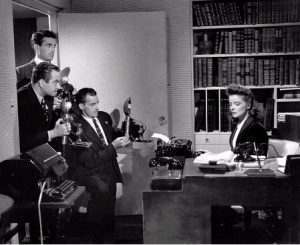Thursday, August 29 at 1pm
ARTISTS AND MODELS
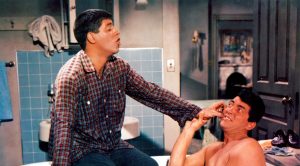
Frank Tashlin (U.S. 1955) 109 min. 35MM. With Dean Martin, Jerry Lewis, Shirley MacLaine.
Dean Martin aspires to sell a comic book concept to a publisher, his chief resource being his comic-book-addled roommate Jerry Lewis; love interests arrive in the form of two Greenwich Village beauties who collaborate on painting and modeling comic-book characters. This offbeat comedy – courtesy of one-time animator turned live-action fantasist Frank Tashlin, one of the Hollywood directors esteemed by the French New Wave’s cineaste filmmakers, comes punctuated by costume designer Edith Head’s bright and deceptively simple designs that epitomize industrious, upbeat youth (Adapted from UCLA program notes).
TOP OF PAGE
Thursday, September 5 at 1pm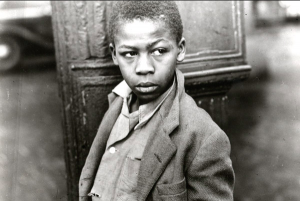
THE QUIET ONE
Sidney Meyers (U.S. 1948) 65 min. 35MM.
Documentarian Sidney Meyers’ reputation largely rests on two films – one of them is The Quiet One, called a masterpiece by The New York Times and nominated by the Academy for an Oscar for Best Documentary. Independently made, it was the first major American film to use a black youth as its protagonist and one of the first non-fiction films to deal with issues of racism and black poverty in America. Shot by photographer Helen Levitt (who also co-directed 1948’s In the Street, one of the classic films about childhood), The Quiet One documents a young boy’s time at the Wiltwyck School for Boys, where he was sent after falling into a deep depression. Preserved by the Library of Congress.
+
STILL 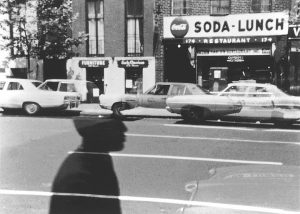
Ernie Gehr (U.S. 1971) 55 min. 16MM.
“Still peers through a New York City street level window, watching the storefronts and windows across the way. People come and go, cars pass by, and the space/time are further articulated by the street sounds which are or are not exactly matched to the activity outside. A single tree grows in the sidewalk across the street, rich in foliage – and somehow, the taxi cabs, autos and people who cross the street are sometimes solid, sometimes transparent. … this very subtle and perplexing interweave of transparency and opaqueness – sends the audience on its way with the feeling they have seen a magician at work” (Richard Foreman, Film Culture). Preserved by Anthology Film Archives.
TOP OF PAGE
Thursday, September 12 at 1pm
DAY OF WRATH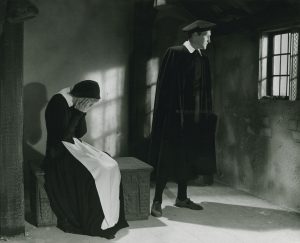
Carl Dreyer (Denmark 1943) 97 min. 35MM. With Thorkild Roose, Lisbeth Movin, Sigrid Neiiendam. Danish with English subtitles.
Filmed during the Nazi occupation of Denmark, Carl Dreyer’s Day of Wrath is a harrowing account of individual helplessness in the face of growing social repression and paranoia. Anna, the young second wife of a well-respected but much older pastor, falls in love with her stepson when he returns to their small seventeenth-century village; stepping outside the bounds of the village’s harsh moral code has disastrous results. Gorgeously photographed and passionately acted, Day of Wrath remains an intense, unforgettable experience.
ANIMA(L)TION

The first (perhaps only complete) book being read in the Film Theory course, Siegfried Kracauer’s Theory of Film: The Redemption of Physical Reality (1960), is upfront about its “neglect” of animation. This program, featuring 8 films by 6 animators, thematizes animal and human figures in relation to language, line and geometry in order to test the form’s relationship to historical and inner worlds. Program: The Moschops (2000, Jim Trainor, 13 min.); Spiders in Love: An Arachnogasmic Musical (1999, Martha Colburn, 3.5 min. 16MM); The Red Book (1994, Janie Geiser, 11 min. 16MM); Blazes (1961, Robert Breer, 3 min. 16MM); Lilly (2007, Jodie Mack, 6 min. 16MM); Master of Ceremonies (1987, Chris Sullivan, 9.5 min.); The Floor of the World (2010, Janie Geiser, 9 min.); 69 (1968, Robert Breer, 5 min. 16MM)
TOP OF PAGE
Thursday, October 3 at 1pm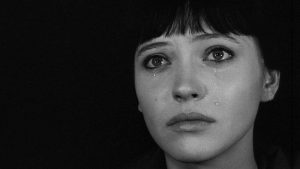
VIVRE SA VIE
Jean-Luc Godard (France 1962) 85 min. 35MM. With Anna Karina, Sady Rebbot, Brice Parain, André S. Labarthe. French with English subtitles.
Vivre sa vie was a turning point for Jean-Luc Godard and remains one of his most dynamic films, combining brilliant visual design with a tragic character study. The lovely Anna Karina, Godard’s greatest muse, plays Nana, a young Parisian who aspires to be an actress but instead ends up a prostitute, her downward spiral depicted in a series of discrete tableaux of daydreams and dances. Featuring some of Karina and Godard’s most iconic moments — from her movie theater vigil with The Passion of Joan of Arc to her seductive poolhall strut — Vivre sa vie is a landmark of the French New Wave that still surprises at every turn.
TOP OF PAGE
Thursday, October 10 at 1pm
SO IS THIS
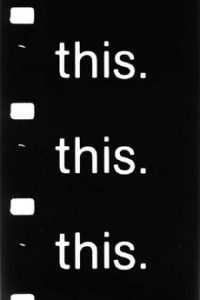
Michael Snow (U.S. 1982) 45 min. 16MM.
So Is This parlays an elegantly simple concept into an unpredictable, cumulatively rich experience. The film is a text in which each shot is a single word… With formalist belligerence, So Is This threatens to make its viewers “laugh cry and change society,” even promising to get “confessional.” A lot of [it] is pretty funny but So Is This is more than a series of gags. Snow manages to defamiliarize both film and language, creating a kind of moving concrete poetry while throwing a monkey wrench into a theoretical debate (is film a language?) that has been going on sporadically for 60 years” (J. Hoberman, The Village Voice).
+
THE TEXT OF LIGHT
Stan Brakhage (U.S. 1974) 71 min. 16MM.
Among the eminent Stan Brakhage’s 350-plus film oeuvre, shines this utterly exquisite gem of purely cinematic beauty.
“All that is is light.” – Dun Scotus Erigena
“To see a world in a grain of sand.” – William Blake
TOP OF PAGE
Thursday, October 24 at 1pm
DANGEROUS
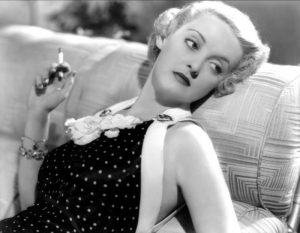 Alfred E. Green (U.S. 1935) 79 min. With Bette Davis, Franchot Tone, Margaret Lindsay.
Alfred E. Green (U.S. 1935) 79 min. With Bette Davis, Franchot Tone, Margaret Lindsay.
In From Reverence to Rape film critic Molly Haskell notes that Bette Davis “was one of the few actresses willing—even eager—to play against audience sympathy… Even in her superfemale roles, the charm has a cutting edge,” for example in Dangerous, where the star plays a hard drinking, self-destructive, once-famous stage actress. She won her first Oscar for the role.
TOP OF PAGE
Thursday, October 31 at 1pm
GANJA & HESS
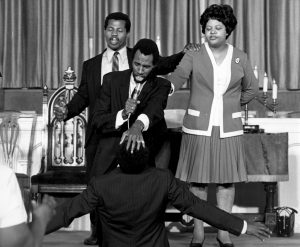 Bill Gunn (U.S. 1973) 113 Min. DCP. With Bill Gunn, Duane Jones, Marlene Clark.
Bill Gunn (U.S. 1973) 113 Min. DCP. With Bill Gunn, Duane Jones, Marlene Clark.
Flirting with the conventions of blaxploitation and horror, Bill Gunn’s revolutionary independent film Ganja & Hess is a highly stylized and utterly original treatise on sex, religion and African American identity. Duane Jones (Night of the Living Dead) stars as anthropologist Hess Green, bestowed with the blessing of immortality. When his killer’s beautiful and outspoken wife Ganja (Clark) comes searching for her missing husband, she and Hess form an unexpected partnership. Spike Lee once said, “Ganja & Hess is not a vampire story. It’s a movie about people.” Later recut and released in an inferior version, this edition represents the original release, restored by The Museum of Modern Art with support from The Film Foundation, and mastered in HD from a 35mm negative.
TOP OF PAGE
Thursday, November 7 at 1pm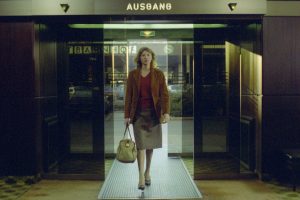
THE MEETINGS OF ANNA
Chantal Akerman (1978) 127 min. DCP. With Aurore Clément, Helmut Griem, Magali Noël. French with English subtitles.
In one of Akerman’s most penetrating character studies, Anna, an accomplished filmmaker, makes her way through a series of European cities to promote her latest movie. Via a succession of eerie, exquisitely shot, brief encounters—with men and women, family and strangers—we come to see her emotional and physical detachment from the world. “More personal than might have been appreciated in 1978, Anna brings Akerman’s career-long concerns to the fore—homelessness, solitude, the child-parent relationship, the nature of sexual identity. It even riffs on itself as a (relatively) commercial movie.” –J Hoberman, The New York Times
WOMAN OF THE YEAR
George Stevens (U.S. 1942) 114 min. DCP. Spencer Tracy, Katharine Hepburn, Fay Bainter.
George Stevens’s Woman of the Year, conceived to build on the smashing comeback Katharine Hepburn had made in The Philadelphia Story, marked the beginning of the personal and professional union between Hepburn and Spencer Tracy, who would go on to make eight more films together. This tale of two newspaper reporters who wed and then discover that their careers aren’t so compatible forges a fresh and realistic vision of what marriage can be. The freewheeling but pinpoint-sharp screenplay by Ring Lardner Jr. and Michael Kanin won an Academy Award, and Hepburn received a nomination for her performance. Woman of the Year is a dazzling, funny, and rueful observation of what it takes for men and women to get along—both in the workplace and outside of it.
TOP OF PAGE
Thursday, November 21 at 1pm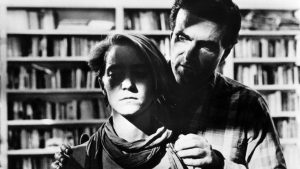
THE MAN WHO ENVIED WOMEN
Yvonne Rainer (U.S. 1985) 125 min. 16MM. With Jackie Raynal, Anne Friedberg, Larry Loonin.
Dancer, choreographer and founding member of the avant-garde Judson Dance Theater, Yvonne Rainer is also a filmmaker. Among her several remarkable features is this wry chronicle of the aftermath of a breakup between a philandering professor, and his artist wife, voiced by choreographer Trisha Brown. Yet the work’s concerns radiate far beyond the couple, expanding to include film history and on-the-ground politics alike—punctuating the piece are a variety of cinematic quotations, from Hollis Frampton to Barbara Stanwyck, as well as documentary footage of spirited exchanges about American imperialism in Latin America and the housing crisis in New York. Explored throughout, Rainer wrote, “are the contrasts and outright contradictions that pervade many areas of [a] man’s life,” like his theoretical commitment to feminism relative to the fact of his womanizing (adapted from Film at Lincoln Center program notes).
TOP OF PAGE
Thursday, December 5 at 1pm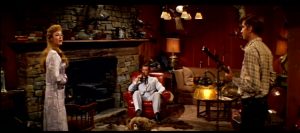
HOME FROM THE HILL
Vincente Minnelli (U.S. 1960) 150 min. 35MM. With Robert Mitchum, Eleanor Parker, George Peppard, George Hamilton.
Most famous for his musicals (like Meet Me in St. Louis) Minnelli also made unforgettable melodramas, like this widescreen epic of sexuality in small-town America, a Faulknerian saga about an overbearing Texas rancher’s efforts to induct his introverted son into “the company of men.” Robert Mitchum stars as the macho, philandering patriarch who battles his wife for the loyalty of their soft-spoken offspring Theron (Hamilton). One of Minnelli’s sensitive young men, Theron is an adolescent torn between a bullying father and a disappointed, smothering mother. The height of hyperbolic male melodrama, Home From the Hill supports its critique of masculinity through daringly baroque mise-enscène, with Minnelli using camera movement, costume and décor incisively to illuminate and critique (adapted from Harvard Film Archive program notes).

